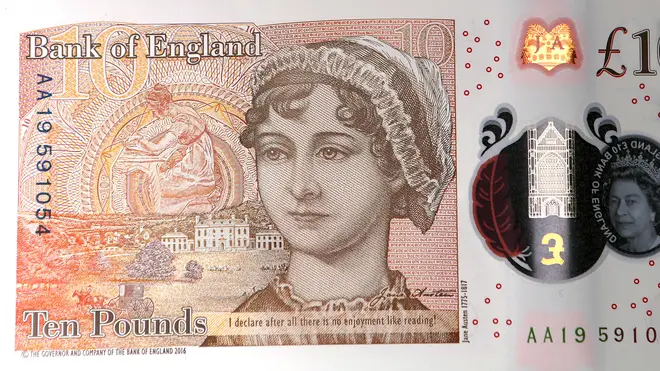
Tom Swarbrick 4pm - 6pm
8 March 2021, 00:04

Florence Nightingale, Elizabeth Fry and Jane Austen are the only females to feature on Bank of England notes since 1970, apart from the Queen.
Calls have been made for more women to be celebrated on banknotes, with only three females having appeared as the main historical figure on the reverse of Bank of England notes since 1970.
Real-life people from the past have featured on its banknotes since 1970 and the first woman – Florence Nightingale – appeared in 1975.
Sarah Coles, from Hargreaves Lansdown, said that women’s achievements have often generally been played down by society in the past.
The #NewTenPoundNote featuring Jane Austen: coming 14 September 2017. https://t.co/VMGsueavyh pic.twitter.com/f6PF9DWglM
— Bank of England (@bankofengland) September 12, 2017
She said: “It’s not just a problem with how people are selected; it also comes down to society itself, and the way women have been sidelined in history.
“If you consider science, before the 20th century, often the only way women could access science was by collaborating with men, in which case they were assumed to be more junior, and men were credited with their collaborative discoveries.
“And it’s a problem with the way we write our histories too.”
Nightingale, who is celebrated for nursing wounded troops during the Crimean War, appeared on the £10 note between 1975 and 1992.
Prison reformer Elizabeth Fry was the next woman to be the main historical figure on a banknote, from 2002 to 2016.
A row erupted when it emerged that Fry would be replaced on the £5 note by former prime minister Sir Winston Churchill – raising the prospect of a men-only line-up on the reverse of Bank of England notes.
However, since 2017, Pride And Prejudice author Jane Austen has appeared on the £10 note, with men featuring on the £5, £20 and £50 notes.
Monday March 8 marks International Women’s Day, celebrating the social, economic, cultural and political achievements of women.
Felicia Willow, chief executive of the Fawcett Society, said: “According to the Bank of England, our notes feature those who have ‘shaped UK society through their thought innovation, leadership or values’ – so where are all the brilliant women have have done just that?
“Women make up 50% of the UK population and yet just 25% of our currency celebrates their achievements. We live in a diverse society and it’s about time our cultural iconography reflected this. We need to see more public recognition of the achievements of women.”
The Queen’s portrait ensures that there is always a female presence on banknotes.
Women appeared in the background of the £20 note between 1991 and 1999.
But the main figure on that note was a man, Michael Faraday, who was depicted lecturing in front of a group of women and men at the Royal Institution in 1855. Women were able to join the Royal Institution and attend its lectures after it was set up in 1799.
Female symbols have also appeared on banknotes, such as Britannia, and Saint Cecilia, the patron saint of musicians, who appeared on a Sir Edward Elgar £20 note, according to the Bank of England Museum website.
In recent years the Bank has been using a new method to select those depicted on notes.
Changes were made to the selection process in 2014.
The Banknote Character Advisory Committee selects a broad field, and then members of the public suggest names.
The historical figure needs to be a real person and they must be dead.
The committee then agrees a shortlist and the final decision about who appears is made by the Governor.
Artist JMW Turner, who appears on the £20 note, was the first person selected using the new method.
Codebreaker Alan Turing was later chosen to appear on the £50 note from 2021, following 227,299 nominations from the public for a scientist to appear on the new note.
Here are the historical characters appearing on Bank of England banknotes since 1970:
– William Shakespeare, £20
– Duke of Wellington, £5
– Florence Nightingale, £10
– Sir Isaac Newton, £1
– Sir Christopher Wren, £50
– George Stephenson, £5
– Michael Faraday, £20
– Charles Dickens, £10
– Sir John Houblon, £50
– Sir Edward Elgar, £20
– Elizabeth Fry, £5
– Charles Darwin, £10
– Adam Smith, £20
– Matthew Boulton and James Watt, £50
– Sir Winston Churchill, £5
– Jane Austen, £10
– JMW Turner, £20
– Alan Turing, £50 (entering circulation in 2021)